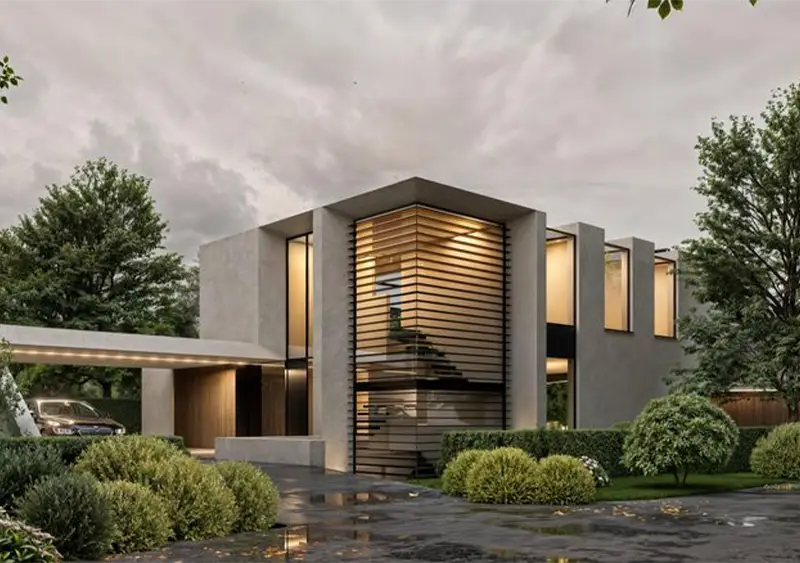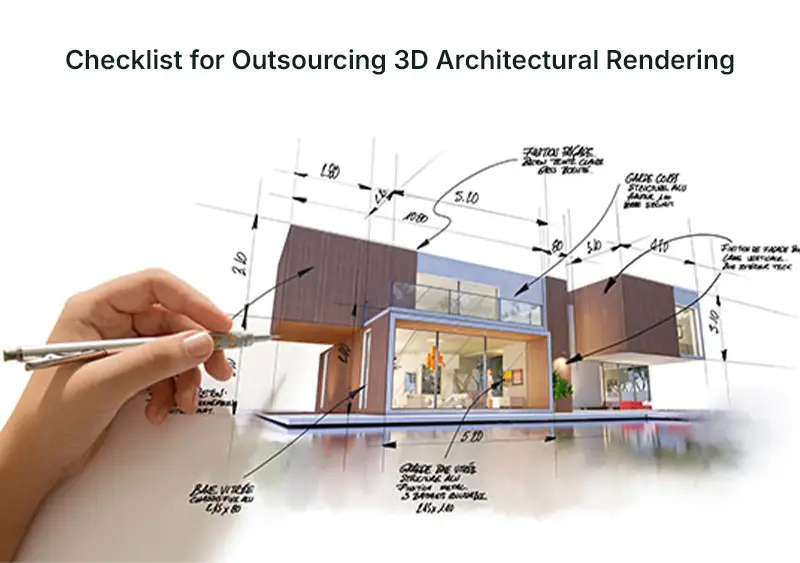The Ultimate Checklist for Outsourcing 3D Architectural Rendering
From plan to photoreal - your guide to outsourcing 3D rendering checklist.

5 MIN READ
May 26, 2025

Written By
Sasikumar Janakiraman
For many design firms and developers, outsourcing 3D Architectural rendering isn’t just about keeping up with deadlines. It’s about getting visuals that work. Ones that explain the space better than words ever could. Ones that help win approvals or get a hesitant client to say yes.
Of course, not every rendering partner gets it right. Some miss the mark entirely either the style feels off, or the details are wrong, or the whole thing just lacks life. And when that happens, the entire project can lose momentum.
That’s why it helps to know what to look for before handing over your plans. This guide breaks down what really matters when outsourcing 3D rendering so the next set of visuals doesn’t just look good, but actually moves the project forward.
Your Checklist for Outsourcing 3D Architectural Rendering (The Right Way)
Getting good results from an outsourcing partner isn’t just about their skills it’s about how well the process is set up. Here’s a practical checklist that helps design teams set the tone, avoid common pitfalls, and get the visuals they actually need.

1. Know What You’re Asking For
Before anything is sent over, define what the output should be. Is the project focused on exteriors, interiors, a marketing walkthrough, or a planning board submission? Be clear about the format too whether the visuals are meant for online use, print brochures, or investor decks.
Things like the number of views, expected resolution, animation needs, and even planning conditions that might affect how something is shown all of it matters upfront. Without these details, even a skilled studio can only guess.
2. Don’t Just Look at Portfolios Read Between the Lines
It’s easy to be impressed by glossy visuals, but what you’re really looking for is depth. Does the studio capture texture and material honestly? Do their renders feel connected to real architecture or are they all style, no structure?
Check for consistency. See if they’ve handled projects like yours before residential, commercial, hospitality. Ask about delivery timelines and what clients have said about their responsiveness. If you’re unsure, a small trial project can say more than a long sales pitch.
To better understand what sets high-quality renders apart from the rest, explore our breakdown of 3D architectural visualization techniques.
3. Set Up Communication That Works in Real Life
A project that looks simple on paper can quickly go off track without the right flow of information. Decide how files will be exchanged, who gives approvals, and how feedback will be shared. Some teams prefer Slack or Trello; others work better over email and structured folders.
Whatever the system, it should make it easy to track changes, avoid version mix-ups, and reduce back-and-forth. When this is sorted early, the creative process becomes faster and far less stressful.
4. Don’t Skip the Paperwork
It might feel formal, but contracts and NDAs protect everyone. Before sharing your plans or design models, make sure ownership, usage rights, and confidentiality terms are written down.
Be clear on how payments will be handled, how many changes are included in the price, and what happens if timelines slip. These are the small details that save big headaches later.
5. Write a Brief That Sets the Studio Up for Success
Even the best rendering studios can’t deliver great results without the right input. A thoughtful brief should include CAD files, 3D models (if available), mood references, and a few lines on what the visual should communicate whether that’s a sense of calm, luxury, function, or scale.
Don’t forget to mention practical details like time of day, camera angle, material choices, or landscaping elements. The goal isn’t to micromanage it’s to provide just enough context to get a render that feels aligned, not guessed.
6. Make Feedback Specific and Manageable
Revisions are part of the process, but how they’re handled makes all the difference. It helps to have two or three focused review rounds, each with clear notes.
Instead of vague comments like “make it look better,” try feedback like “reduce shadow near the entrance. It's hiding the detailing.” Use tools that let you annotate directly on images or leave timestamped notes for clarity.
7. Think Beyond One Project
If the first collaboration goes well, don’t stop there. A good rendering partner becomes easier to work with over time. They learn your design language, your workflow, and even your preferences without needing reminders.
Document what works. Share libraries of commonly used materials. If the need is ongoing, look into retainers or phase-based agreements. Long-term, this reduces cost and improves turnaround without compromising quality.
For a deeper look at how to build sustainable offshore partnerships, check out our guide to outsourcing 3D visualization effectively.
Closing Thoughts
Outsourcing 3D Architectural Rendering isn’t just about freeing up your internal team. It’s about making your design process sharper, faster, and easier to communicate. When done right, it helps turn sketches and floor plans into visuals that do more than just look good—they make people understand the design.
A reliable rendering partner becomes more than a vendor. They become part of how your ideas take shape and move forward. With the right setup, what starts as a concept becomes something that clients and stakeholders can see, feel, and get behind.
If the goal is clarity, alignment, and momentum, then a strong visual partner is a key piece of the puzzle.
Explore how ZealousXR supports design teams through high-quality 3D rendering built to reflect your intent and meet your pace. Accurate. Expressive. On schedule.
About the writer :
Sasikumar Janakiraman, as the Creative Director at Zealous Services, brings a unique mix of creativity and technical ... skill. He’s passionate about 2D and 3D design, leading teams to create stunning 3D models and visualizations. Sasikumar loves working closely with clients, making sure their ideas come to life in the best possible way. His goal? To make design feel simple and exciting.
Read MoreFrequently Asked Questions (FAQ)
What’s the advantage of outsourcing 3D architectural rendering instead of doing it in-house?
Outsourcing opens the door to specialized skills without the long-term costs of building an internal team. For firms juggling tight timelines or large volumes, it’s a smart way to stay flexible while keeping quality high. It also makes it easier to scale up quickly especially for projects that require complex, high-detail visuals.
Are there legal documents I should have in place before sharing project files?
Yes. Always start with an NDA to protect your designs and data. You’ll also need a service agreement that defines deadlines, revision policies, payment terms, and who owns the final output. If you don’t want the studio to share your work publicly, make sure that’s clearly written in.
Is it possible to build a long-term partnership with a rendering studio?
Not only is it possible, it's often the best path forward. When a studio gets to know your aesthetic, your workflow, and how your team operates, they become much faster and more accurate over time. That kind of relationship adds real value, especially across multi-phase or recurring projects.
Table Of Contents
Your Checklist for Outsourcing 3D Architectural Rendering (The Right Way)
Know What You’re Asking For
Don’t Just Look at Portfolios Read Between the Lines
Set Up Communication That Works in Real Life
Don’t Skip the Paperwork
Write a Brief That Sets the Studio Up for Success
Make Feedback Specific and Manageable
Think Beyond One Project
Closing Thoughts